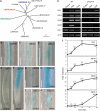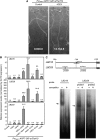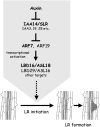ARF7 and ARF19 regulate lateral root formation via direct activation of LBD/ASL genes in Arabidopsis
- PMID: 17259263
- PMCID: PMC1820965
- DOI: 10.1105/tpc.106.047761
ARF7 and ARF19 regulate lateral root formation via direct activation of LBD/ASL genes in Arabidopsis
Abstract
Lateral root formation in Arabidopsis thaliana is regulated by two related AUXIN RESPONSE FACTORs, ARF7 and ARF19, which are transcriptional activators of early auxin response genes. The arf7 arf19 double knockout mutant is severely impaired in lateral root formation. Target-gene analysis in arf7 arf19 transgenic plants harboring inducible forms of ARF7 and ARF19 revealed that ARF7 and ARF19 directly regulate the auxin-mediated transcription of LATERAL ORGAN BOUNDARIES-DOMAIN16/ASYMMETRIC LEAVES2-LIKE18 (LBD16/ASL18) and/or LBD29/ASL16 in roots. Overexpression of LBD16/ASL18 and LBD29/ASL16 induces lateral root formation in the absence of ARF7 and ARF19. These LBD/ASL proteins are localized in the nucleus, and dominant repression of LBD16/ASL18 activity inhibits lateral root formation and auxin-mediated gene expression, strongly suggesting that these LBD/ASLs function downstream of ARF7- and ARF19-dependent auxin signaling in lateral root formation. Our results reveal that ARFs regulate lateral root formation via direct activation of LBD/ASLs in Arabidopsis.
Figures






Similar articles
-
The establishment of asymmetry in Arabidopsis lateral root founder cells is regulated by LBD16/ASL18 and related LBD/ASL proteins.Development. 2012 Mar;139(5):883-93. doi: 10.1242/dev.071928. Epub 2012 Jan 25. Development. 2012. PMID: 22278921
-
The AP2/EREBP gene PUCHI Co-Acts with LBD16/ASL18 and LBD18/ASL20 downstream of ARF7 and ARF19 to regulate lateral root development in Arabidopsis.Plant Cell Physiol. 2013 Aug;54(8):1326-34. doi: 10.1093/pcp/pct081. Epub 2013 Jun 6. Plant Cell Physiol. 2013. PMID: 23749813
-
RLF, a cytochrome b(5)-like heme/steroid binding domain protein, controls lateral root formation independently of ARF7/19-mediated auxin signaling in Arabidopsis thaliana.Plant J. 2010 Jun 1;62(5):865-75. doi: 10.1111/j.1365-313X.2010.04199.x. Epub 2010 Mar 4. Plant J. 2010. PMID: 20230485
-
Pivotal role of LBD16 in root and root-like organ initiation.Cell Mol Life Sci. 2018 Sep;75(18):3329-3338. doi: 10.1007/s00018-018-2861-5. Epub 2018 Jun 25. Cell Mol Life Sci. 2018. PMID: 29943076 Free PMC article. Review.
-
Zoom-in to molecular mechanisms underlying root growth and function under heterogeneous soil environment and abiotic stresses.Planta. 2023 Oct 29;258(6):108. doi: 10.1007/s00425-023-04262-5. Planta. 2023. PMID: 37898971 Review.
Cited by
-
Synthetically derived BiAux modulates auxin co-receptor activity to stimulate lateral root formation.Plant Physiol. 2024 May 31;195(2):1694-1711. doi: 10.1093/plphys/kiae090. Plant Physiol. 2024. PMID: 38378170 Free PMC article.
-
Overexpression of TaLBD16-4D alters plant architecture and heading date in transgenic wheat.Front Plant Sci. 2022 Sep 21;13:911993. doi: 10.3389/fpls.2022.911993. eCollection 2022. Front Plant Sci. 2022. PMID: 36212357 Free PMC article.
-
Common Mechanisms of Developmental Reprogramming in Plants-Lessons From Regeneration, Symbiosis, and Parasitism.Front Plant Sci. 2020 Jul 16;11:1084. doi: 10.3389/fpls.2020.01084. eCollection 2020. Front Plant Sci. 2020. PMID: 32765565 Free PMC article. Review.
-
Auxin controls Arabidopsis adventitious root initiation by regulating jasmonic acid homeostasis.Plant Cell. 2012 Jun;24(6):2515-27. doi: 10.1105/tpc.112.099119. Epub 2012 Jun 22. Plant Cell. 2012. PMID: 22730403 Free PMC article.
-
The Ubiquitin-Specific Protease TNI/UBP14 Functions in Ubiquitin Recycling and Affects Auxin Response.Plant Physiol. 2020 Nov;184(3):1499-1513. doi: 10.1104/pp.20.00689. Epub 2020 Aug 28. Plant Physiol. 2020. PMID: 32859753 Free PMC article.
References
-
- Abel, S., Nguyen, M.D., and Theologis, A. (1995). The PS-IAA4/5-like family of early auxin-inducible mRNAs in Arabidopsis thaliana. J. Mol. Biol. 251 533–549. - PubMed
-
- Casimiro, I., Beeckman, T., Graham, N., Bhalerao, R., Zhang, H., Casero, P., Sandberg, G., and Bennett, M.J. (2003). Dissecting Arabidopsis lateral root development. Trends Plant Sci. 8 165–171. - PubMed
Publication types
MeSH terms
Substances
LinkOut - more resources
Full Text Sources
Other Literature Sources
Molecular Biology Databases

